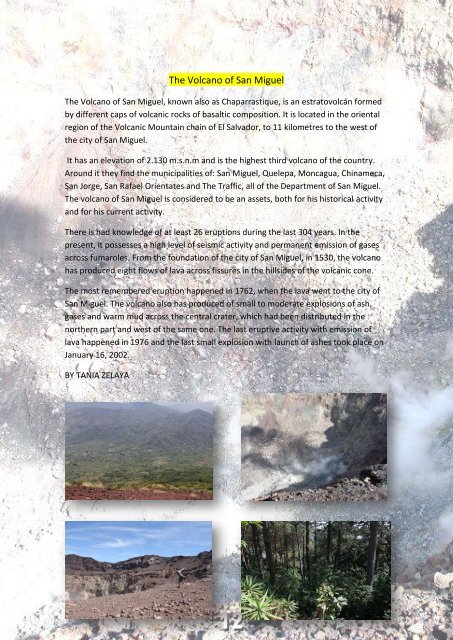You also want an ePaper? Increase the reach of your titles
YUMPU automatically turns print PDFs into web optimized ePapers that Google loves.
The Volcano of San Miguel<br />
The Volcano of San Miguel, known also as Chaparrastique, is an estratovolcán formed<br />
by different caps of volcanic rocks of basaltic composition. It is located in the oriental<br />
region of the Volcanic Mountain chain of El Salvador, to 11 kilometres to the west of<br />
the city of San Miguel.<br />
It has an elevation of 2.130 m.s.n.m and is the highest third volcano of the country.<br />
Around it they find the municipalities of: San Miguel, Quelepa, Moncagua, Chinameca,<br />
San Jorge, San Rafael Orientates and The Traffic, all of the Department of San Miguel.<br />
The volcano of San Miguel is considered to be an assets, both for his historical activity<br />
and for his current activity.<br />
There is had knowledge of at least 26 eruptions during the last 304 years. In the<br />
present, it possesses a high level of seismic activity and permanent emission of gases<br />
across fumaroles. From the foundation of the city of San Miguel, in 1530, the volcano<br />
has produced eight flows of lava across fissures in the hillsides of the volcanic cone.<br />
The most remembered eruption happened in 1762, when the lava went to the city of<br />
San Miguel. The volcano also has produced of small to moderate explosions of ash,<br />
gases and warm mud across the central crater, which had been distributed in the<br />
northern part and west of the same one. The last eruptive activity with emission of<br />
lava happened in 1976 and the last small explosion with launch of ashes took place on<br />
January 16, 2002.<br />
BY TANIA ZELAYA<br />
14



